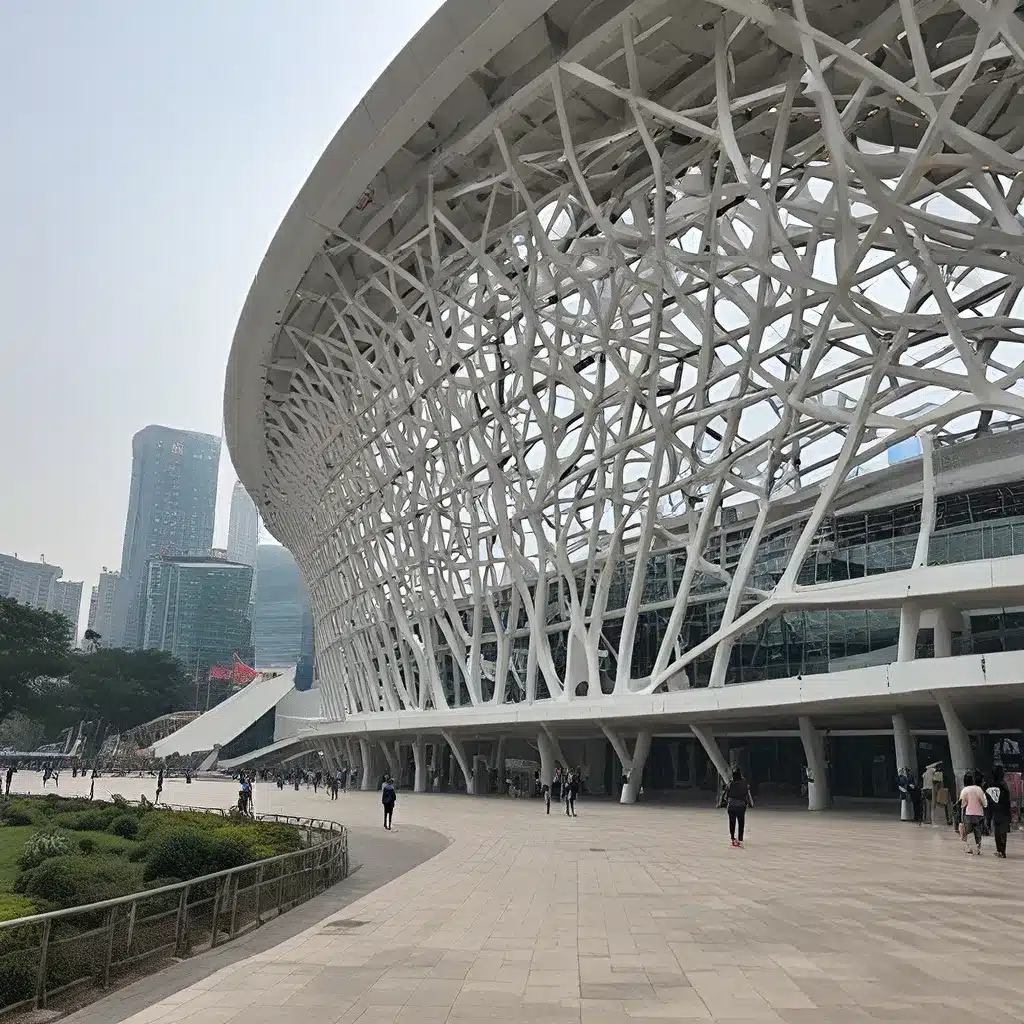
The Shenzhen Universiade Center, situated in the bustling city of Shenzhen, China, is a remarkable architectural masterpiece that has captivated the attention of sports enthusiasts, design aficionados, and curious travelers alike. This state-of-the-art stadium complex, constructed for the 2011 Universiade Games, is a testament to the city’s commitment to innovation and its desire to leave a lasting legacy.
Architectural Marvels and Innovations
The Shenzhen Universiade Center is a true architectural gem, blending cutting-edge design with functional efficiency. The stadium’s striking, futuristic appearance is the result of a collaborative effort between renowned architects and engineers, who skillfully integrated advanced building materials and sustainable design principles.
One of the most distinctive features of the Universiade Center is its unique roof structure. Inspired by the shape of a lotus flower, the roof is a masterpiece of engineering, boasting a lightweight yet sturdy design. The roof’s intricate lattice-like framework is made of reinforced concrete and steel, creating a visually stunning and aerodynamic form that not only enhances the building’s aesthetics but also improves its environmental performance.
The specialized ventilation and cooling systems employed in the Universiade Center are another testament to the venue’s innovative design. The stadium’s large, operable windows and strategically placed vents allow for natural cross-ventilation, reducing the need for energy-intensive air conditioning. This eco-friendly approach helps to minimize the building’s carbon footprint and aligns with the city’s broader sustainability initiatives.
Functional Versatility and Adaptability
The Shenzhen Universiade Center is not merely a stunning architectural achievement; it is also a highly versatile and adaptable venue that can accommodate a wide range of sports and events. The main stadium, which can seat up to 60,000 spectators, is designed to host a variety of sporting disciplines, from athletics and football to basketball and badminton.
In addition to the main stadium, the Universiade Center complex includes several smaller specialized venues, such as the gymnastics hall, swimming pool, and indoor sports arena. These facilities are equipped with state-of-the-art technology and equipment, ensuring that they can cater to the specific needs of different sporting events and athletes.
Flexibility and adaptability are key design principles that have been implemented throughout the Universiade Center. The modular nature of the venue’s infrastructure allows for easy reconfiguration and repurposing, enabling the efficient hosting of various events and activities, from international competitions to cultural performances and community gatherings.
Sustainable Design and Environmental Considerations
Sustainability is a core tenet of the Shenzhen Universiade Center’s design, reflecting the city’s commitment to environmental responsibility. The stadium’s energy-efficient systems, including the innovative roof structure and natural ventilation, contribute to reducing the venue’s carbon footprint and overall environmental impact.
Moreover, the Universiade Center’s landscaping and green spaces are an integral part of its design. The complex features lush, meticulously-maintained gardens and public plazas, providing a serene and inviting atmosphere for visitors. These green spaces not only enhance the overall aesthetic appeal of the venue but also play a crucial role in mitigating the urban heat island effect and improving the local ecosystem.
The Universiade Center’s commitment to sustainability extends beyond its physical design. The venue has also implemented robust waste management and recycling programs, further demonstrating its dedication to environmental conservation and responsible resource utilization.
Ongoing Research and Future Developments
The Shenzhen Universiade Center is not merely a static architectural marvel; it is a dynamic and evolving entity that continues to be the subject of ongoing research and development. Experts and scholars from various disciplines, including architecture, engineering, and environmental sciences, are actively studying the venue’s design, performance, and impact, with the aim of further refining and improving sustainable building practices.
The Old Stadium Journey website provides a comprehensive platform for individuals interested in exploring the world’s most remarkable sports venues, including the Shenzhen Universiade Center. By delving into the center’s unique features and innovative design, visitors can gain a deeper appreciation for the role that architecture and sustainability play in shaping the future of sports facilities.
As Shenzhen continues to evolve and expand, the Universiade Center remains a testament to the city’s commitment to excellence and its desire to push the boundaries of what is possible in the realm of sports infrastructure. With its cutting-edge design, environmental consciousness, and adaptable functionality, the Shenzhen Universiade Center stands as a pioneering example of how modern architecture can seamlessly integrate with the needs of the 21st-century sports industry and the broader community.
Conclusion
The Shenzhen Universiade Center is a true marvel of modern architecture and engineering. Its innovative design, sustainable features, and functional versatility have earned it a reputation as one of the most impressive sports venues in the world. As the city of Shenzhen continues to evolve, the Universiade Center is poised to remain a shining example of how visionary thinking and a commitment to excellence can transform the landscape of sports and urban development.

